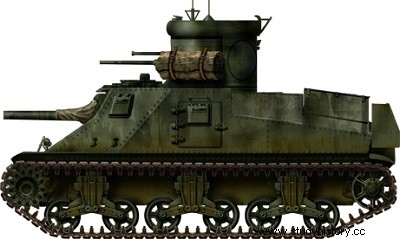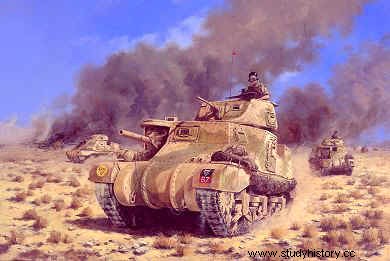
M3, M3A1, M3A2, M3A3, M3A4, M3A5 and variants Type:medium tank.
Crew :6 men.
Armament :a 75 mm M2 or M3 gun under a side turret; a 37 mm M5 or M6 gun under turret; a coaxial 30 M1919A4; a 30 in the turret cupola; two 30 bonnets.
Shielding :
minimum 12mm;
maximum 37 mm.
Dimensions:
length :5.64 m;
width :2.72 m:
height :3.12 m.
Weight in combat order :27.2 t.
Ground pressure :Q94 kg/cm2.
Mass power:12.7 hp/t.
Engine :Wright Continental R-975-EC2 9 cyl. air-cooled gasoline radials, developing 360 hp at 2,400 rpm.
Performance:
road speed speed:42 km/h;
off-road speed speed:26 km/h;
road range :190 km;
vertical obstacle :0.6 m;
clean cut :1.9m; 60% slope.
Service Time :introduced in 1941 in the American and British armies. Also used by Canada and the Soviet Union.
In 1939, reports from the battlefield showed that the 37 mm of the American medium tank M2 did not have the power necessary for modern warfare and the 75 mm howitzer was mounted, as an experiment, in the side turret on the right of the Medium Tank T5 Phase III, a vehicle closely related to the M2. Previously a machine of this kind would have been classified as a self-propelled howitzer. Meanwhile, in the United States. as part of the rearmament program William S Knudsen, president of the General Motors Corporation, had been admitted as a co-opted member of the National Defense Advisory Committee (NDAC) to organize the war effort.
In the summer of 1940, faced with the events in Europe, no one could doubt more than a large number of tanks, better armed. would soon be essential. The 329 M2A4 light tanks contracted for were now only a drop in the ocean and the industry did not seem able to honor the order of 1,500 M2 medium tanks that was envisaged. in high places.
In 1940, the solution was thought to be found by improving the M2 with better armor and installation in a side turret, in the hull; of the 75 mm M1897 gun (designated T7). The new machine received from the Ordnance Committee the designation of medium tank M3 on July 11, 1940 and on August 28, 1940, the order of 1,000 M2A1, placed only fifteen days earlier was carried over to the M3.
Until then, America's tank needs, which were very modest, had been largely covered by the heavy mechanical industry, which was better equipped, however. for the production of railway equipment than for the mass production of modern tanks. Knudsen, now a lieutenant general, considered that apart from fabricating and casting armor, building a tank or building an automobile made little difference.
So he came to terms with K.T. Keller, president of the Chrysler Corporation, to have the company lease 100 acres on which to build a new tank factory. This land in Warren, Michigan, was to become the arsenal—owned by the government but operated by Chrysler—from which some 25,000 armored vehicles were produced during World War II. The M3 went straight from the drawing board to the assembly line; Chrysler, the American Locomotive Company and Baldwin Locomotive Works had all produced their pilot model by April 1941.
Production, launched in August 1941, continued until December 1942, when it amounted to 6,258 vehicles of the M3 series. Of this total, 3,352 were due to Chrysler, 685 to Alco, 1,220 to Baldwin. 501 at Pressed Steel and 500 at Pullman. This stat illustrates what was basically the first application to tanks of mass production techniques in the automotive industry.
During production, several modifications were necessary to compensate for the shortage of certain elements and to improve the tank as a whole. The hull of the M3A1, a cast assembly produced by Alco, had no side hatches so as not to diminish the resistance of the armour.
A wrought steel hull, stronger than the riveted assembly of the M3, was employed on the M3A2 to lower the weight. Baldwin made 12 units of this model and 322 units of the M3A3 where two coupled General Motors 6-71 bus diesels replaced the Wright radial engine. In all other respects the M3A3 was identical to the M3A2.
The M3, the M3A1 and the M3A2 could also receive a Guiberson diesel engine, in which case the designation became for example, M3A1 (Diesel). Faced with a shortage of the Wright engine in 1941, Chrysler combined five standard automobile engines into one tank powerplant. This engine, nicknamed "Eggbeater", led to modifications to the hull and suspension and this new version was designated M3A4 The hull was riveted as on the M3; 109 specimens were produced.
The M3A5 mounted the twin General Motors diesels of the M3A3 in the riveted hull of the M3; Baldwin made 591 of them.

The British Army named their M3s Grant
(after General Ulysses S. Grant) or Lee (after General Robert E Lee). A British commission had arrived in the United States in 1940 with the intention of ordering British-designed tanks from American companies.
imminent, the CCDN did not grant the authorization to build tanks on British design. As a result of this refusal, the M3 was chosen as an alternative. The machines purchased by the British commission from Pullman and Pressed Steel (which however included a British-designed turret) were given the name Grant I. The Lee name was given to the standard M3 (Lee I), M3A 1 (Lee II , the M3A3 (Lee IV), the M3A3 (diesel) (Lee II) and the M3A4 (Lee VI), while the M3A5 became the Grant II, all these tanks being supplied under Lend-Lease.
The Grant felt its weight at the Battle of Gazala on 27 May 1942, the first occasion when the 8th Army managed to establish some parity with the 75 mm of the PzKpfw IV, although it took some time to resolve the problems caused by the fuze of the HE shell. By October 1942 the British had received another 350 M3s and these tanks made a valuable contribution to the victory at El Alamein in November of that year.
A few M3s were sent to England for training crews but most left for North Africa and the Middle East. With the gradual entry into service of the M4 medium tank in 1942, the M3 was gradually replaced, sent to the Far East to relieve the Matilda, Valentine and Stuart. By April 1943 the M4 was in full production and the M3 was finally declared obsolete on March 16, 1944.
But it continued its career in the form of variants such as the M7 Priest and the TRV M31 recovery tank. The machine also lent its chassis to numerous experimental adaptations, including the Mine Exploder T1 mine tank, the TRV T2 (M31), the 155 mm self-propelled gun Gun Motor Cardage T6 (M12), the Shop Tractor T10 (a CDL or searchlight carrier), Cargo Carrier T14, Artillery Heavy Tractor T16, Gun Motor Carnage 3-inch T24, Howitzer Motor Carnage T25 self-propelled howitzer, Gun Motor Carnage 75mm T26, Howitzer Motor Carnage T32 (M7 "Priest"), the 40mm Gun Motor Carnage T36, the 3-inch Gun Motor Carnage T40 (M9), the 25-pound Gun Motor Carnage T51, finally the flamethrower versions (there are some there were several employing the E3 and M5R2 launchers).
The M3 series vehicles supplied to the British Army were also used for a variety of specialist missions such as recovery, mine clearance command and searchlight target location.
